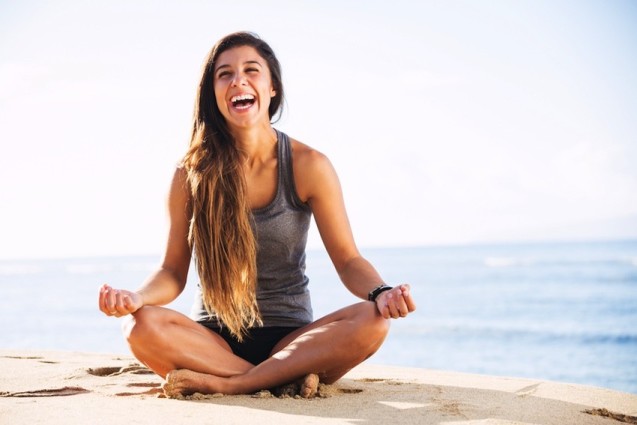 The ancient practice of yoga is a spiritual and physical discipline promoting transformation and enlightenment through breathing, meditation, and movement. Known for its relaxing and health-boosting benefits, yoga has been a favorite activity for mine over the last decade. Nothing is more calming than having all the worries of the world melt away on the mat. Through the years, I have explored different variations of the practice including Hatha, Vinyasa, Restorative, Bikram, and Yin yoga. Each type is unique and beneficial in its own right, varying in sequences, flow, and speed. I have never been loyal to one type of yoga, often switching it up due to my body’s needs or out of my own interest. Therefore, when I came across Laughter Yoga I was extremely intrigued.
The ancient practice of yoga is a spiritual and physical discipline promoting transformation and enlightenment through breathing, meditation, and movement. Known for its relaxing and health-boosting benefits, yoga has been a favorite activity for mine over the last decade. Nothing is more calming than having all the worries of the world melt away on the mat. Through the years, I have explored different variations of the practice including Hatha, Vinyasa, Restorative, Bikram, and Yin yoga. Each type is unique and beneficial in its own right, varying in sequences, flow, and speed. I have never been loyal to one type of yoga, often switching it up due to my body’s needs or out of my own interest. Therefore, when I came across Laughter Yoga I was extremely intrigued.
I first learned about Laughter Yoga in Hong Kong from a coworker who had previously attended a class. I thought I had misheard her, say what? Laughter Yoga? Recently, I feel as if yoga is beginning to take on a new identity, generating interesting styles such as Acro Yoga. However, Laughter Yoga seemed to be on a whole different level. Being the adventurous and curious spirit that I am, I immediately wanted to learn more. Plus, I could always use a good hearty laugh!
Laughter Yoga was developed in 1995 by a doctor in India named Dr. Madan Kataria. The idea behind the practice stemmed from an article written by Dr. Kataria on the benefits of laughter on the mind and body. An experiment was carried out to determine what kind of impact laughter had on the body, and if there was a difference between authentic laughter and self-generated laughter. The conclusion was that the body couldn’t tell the difference between the two. The fun research soon turned into a weekly club resulting in the birth of Laughter Yoga.
Laughter Yoga is a unique form of yoga combining a series of breathing techniques and childlike role playing. The act of role playing is combined with “fake” laughing with the intention of setting off genuine laughter. Like traditional yoga, Laughter Yoga offers several wellness benefits:
1. A better mood.
2. Reduces physical, mental and emotional stress.
3. Strengthens immune system.
4. Promotes positive energy, boosting quality of life.
5. Provides coping mechanisms for difficult situations.
In addition to all of the benefits, this variation of yoga helps increase endorphins through laughter and aerobic experience, making this the ultimate workout experience.
After doing my research, I was looking forward to a carefree and playful yoga session. I was fortunate to find a class close to me that happened to be free. With an open mind, I went into Laughter Yoga not really knowing what to expect other than a belly full of laughter and the opportunity to let my inner child out.
The Experience
Walking up to the class, I began to mentally prepare myself for the next 45 minutes, knowing that I was about to be completely outside of my comfort zone.
Set along the harbor in Hong Kong, I was immediately put at ease by the stunning backdrop and a smiling face. The group leader, wearing a yellow Little Miss Sunshine shirt, greeted me warmly as I hesitantly walked up. Surround by locals, I knew I was in for an interesting experience when I realized I was the only expat in attendance. However, the group leader alleviated my worries by giving me a brief explanation of the class and assured that her instructions would be translated from Cantonese to English. Feeling more confident, I joined the other members in the circle.
The class began with a short explanation of Laughter Yoga and a happiness assessment. The instructor wanted us to rate how often we smiled each day and if we needed to boost our happiness levels. The verdict was that we could all use some extra joy. From there, we transitioned into taking slow deep breaths while folding over to touch our toes. The slow breaths then turned into making “ho” and “ha” sounds on the exhale, with our hands placed on our bellies. We then practiced making different laughing noises, “he he, ha ha, ho ho.” Finishing up the warm up, we moved onto role-playing.
The instructor demonstrated different scenarios to act out while simultaneously laughing. We would first act out the movements while laughing then move about the circle acting out the scenario with group members, all while “fake” laughing. The different scenarios ranged from dancing, washing our hair and body, walking in a space suit, and pretending to speak an alien language. Every time we completed one act, we would use positive reinforcement by chanting, “very good, very good, yeah!” With each scene, the fake laughter would soon turn into real laughter simply because we were acting insanely ridiculous. As the class winded down, we gave each other high fives and brushed our positive energy away from our bodies out into the world. We ended by chanting positive affirmations about being the happiest people in the universe and promised to pass on the love.
Conclusion
Without a doubt, Laughter Yoga was one of the most unique yoga classes I have taken thus far. It is not the traditional yoga class I tend to go for, lacking the elements of stretching and poses. However, with the combination of breathing techniques and laughing I felt as if it released pent up tension and helped strengthen my core. All in all, I ended up having a blast and left with a smile on my face. NamaYAY!
Also see: I Tried It – Aerial Yoga
Also by Jess: Why You Should Live Abroad At Least Once
Finding Balance in a Social World
Get more like this—Subscribe to our daily inspirational newsletter for exclusive content!
__
Photo: Shutterstock; Jess Davis





